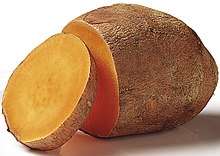芋
| ||||||||
| ||||||||
Translingual
Han character
芋 (radical 140, 艸+3, 6 strokes, cangjie input 廿一木 (TMD) or X廿一木 (XTMD), four-corner 44401, composition ⿱艹于)
References
- KangXi: page 1018, character 8
- Dai Kanwa Jiten: character 30670
- Dae Jaweon: page 1476, character 8
- Hanyu Da Zidian: volume 5, page 3174, character 3
- Unihan data for U+828B
Chinese
| simp. and trad. |
芋 | |
|---|---|---|
| variant forms | 芌 | |
Glyph origin
| Characters in the same phonetic series (于) (Zhengzhang, 2003) | |
|---|---|
| Old Chinese | |
| 侉 | *qaːls |
| 夸 | *kʰʷraː |
| 姱 | *kʰʷraː |
| 胯 | *kʰʷraː, *kʰʷraːs, *kʰʷaːs |
| 跨 | *kʰʷraː, *kʰʷraːʔ, *kʰʷraːs, *kʰʷaːs |
| 誇 | *kʰʷraː |
| 垮 | *kʰʷraːʔ |
| 銙 | *kʰʷraːʔ |
| 骻 | *kʰʷraːʔ |
| 咵 | *kʰʷraːʔ |
| 釫 | *ɢʷraː, *qʷaː |
| 摦 | *ɡʷraːs |
| 鮬 | *pɢʷaː, *kʰʷaː |
| 嶀 | *qʰʷl'aː |
| 扝 | *kʰʷaː, *qʷaː |
| 刳 | *kʰʷaː |
| 郀 | *kʰʷaː |
| 挎 | *kʰʷaː |
| 袴 | *kʰʷaːs |
| 絝 | *kʰʷaːs |
| 褲 | *kʰʷaːs |
| 恗 | *qʰaː |
| 洿 | *ɡʷaːʔ, *qʷaː |
| 瓠 | *ɡʷlaː, *ɡʷlaːs |
| 鄠 | *ɢʷlaːʔ |
| 污 | *qʷaː, *qʷaːs |
| 杇 | *qʷaː |
| 圬 | *qʷaː |
| 鴮 | *qʷaː |
| 盓 | *qʷaː |
| 汙 | *qʷaːs, *ɢʷa |
| 樗 | *qʰʷl'a |
| 摴 | *qʰʷl'a |
| 荂 | *pqʰʷa, *qʰʷa |
| 雩 | *qʰʷla, *ɢʷla |
| 吁 | *qʰʷa, *ɢʷas |
| 盱 | *qʰʷa |
| 訏 | *qʰʷa |
| 扜 | *qʰʷa, *qʷa |
| 旴 | *qʰʷa |
| 冔 | *qʰʷaʔ |
| 紆 | *qʷa |
| 陓 | *qʷa |
| 迂 | *qʷa, *qʷaʔ, *ɢʷa |
| 虶 | *qʷa |
| 于 | *ɢʷa |
| 盂 | *ɢʷa |
| 竽 | *ɢʷa |
| 邘 | *ɢʷa |
| 玗 | *ɢʷa |
| 芋 | *ɢʷa, *ɢʷas |
| 杅 | *ɢʷa |
| 釪 | *ɢʷa |
| 骬 | *ɢʷa |
| 謣 | *ɢʷla |
| 宇 | *ɢʷaʔ |
Phono-semantic compound (形聲, OC *ɢʷa, *ɢʷas) : semantic 艸 (“grass; plant”) + phonetic 于 (OC *ɢʷa) – taro.
Etymology 1
Unclear. Shuowen suggests that the word arises from the startling size of the taro, leading Kai Xu to connect it to 吁 (OC *qʰʷa), which is the sound that one makes when one is startled. However, this seems to be folk etymology.
Compare Proto-Hmong-Mien *wouH (“taro”), Burmese ဝ (wa., “elephant foot yam”), Tibetan གྲོ་མ (gro ma, “Potentilla anserina, a plant with small edible tubers”). There are various theories on how all these words are related:
- Schuessler (2007) considers it to be an areal word, comparing it to the Hmong-Mien and Burmese words, but does not consider the Tibetan word to be cognate.
- Blench (2012) suggests that the Chinese word is borrowed from Proto-Hmong-Mien and that the Burmese word may be a late loan from Old Chinese.
- STEDT reconstructs Proto-Sino-Tibetan *g/s-rwa (“taro; yam; tuber”), whence the Tibetan word. This etymon is regarded as allofamically related this word and 薯 (OC *djas).
- Baxter and Sagart (2017) also argue that this word is related to the Tibetan word.
Pronunciation
Synonyms
Compounds
Etymology 2
Pronunciation
Etymology 3
Pronunciation
Etymology 4
Pronunciation
Korean
Vietnamese
This article is issued from
Wiktionary.
The text is licensed under Creative
Commons - Attribution - Sharealike.
Additional terms may apply for the media files.
